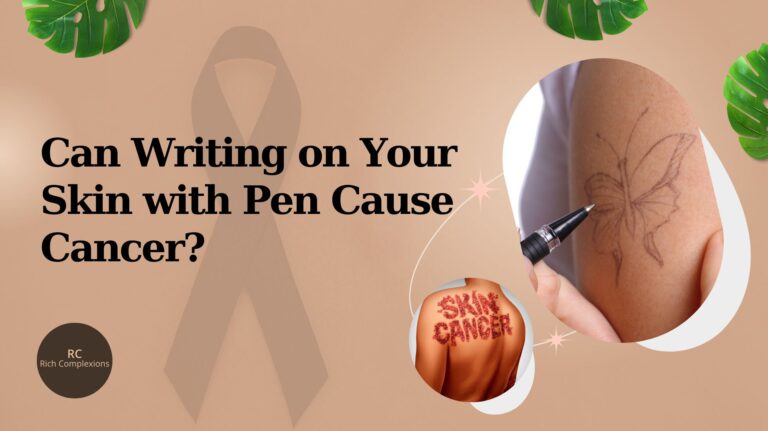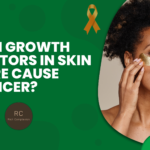Your pen’s ink can be the ink that ends your life! That’s right, researchers have found that pen ink compounds can enter the skin and lead to cancer. So reconsider the idea of writing on your flesh the next time. You might do it as your final act.
Of course, things are not nearly so dramatic in reality. There is no concrete proof that using a pen to write on your skin might cause cancer. The compounds in pen ink, however, have been linked in certain studies to skin toxicity. For instance, a study discovered that the compounds in pen ink might harm and inflame cells. According to a different study, the compounds in pen ink can obstruct the body’s capacity to repair DNA damage.
Therefore, it is usually preferable to refrain from writing with a pen on your skin even though it is unclear whether doing so will definitely result in cancer. There are plenty alternative methods to express yourself without endangering your health.
Why do Young People Write on Their Skin with an Ink Pen?
There are a few reasons why young people might write on their skin with an ink pen.
- Expression. It’s possible for young individuals to express themselves creatively by writing on their bodies. They might wish to draw something, write their name, or write a message. Additionally, it could be a means for them to express their uniqueness or make a point.
- Boredom. Young people have been known to draw on their skin out of boredom. They might not have anything else to do or they might just want to kill some time.
- Peer pressure. Young people may occasionally tattoo their bodies because their buddies are doing it. They can feel the desire to blend in or they might be worried about being left out.
- Attention-seeking. Some teenagers would draw on their skin to draw attention. They may desire attention from others or the feeling of being exceptional.
Does Writing on Skin with an Ink Pen Cause Skin Cancer?
While we frequently appreciate the freedom it provides us to scribble down quick notes or doodle in our free time, many individuals have started to question whether writing with a pen on their skin might truly cause cancer. It’s crucial to comprehend the constraints of this technique before conjuring up ominous situations. It’s doubtful that writing with an ordinary pen on your skin can cause cancer. The majority of pens employ ink that is made up of dyes and pigments that are considered safe for use on skin and other exterior surfaces like paper.
However, care should be taken while taking certain circumstances into account. First off, the frequent use of permanent markers or other pens carries some risk due to the presence of potentially toxic compounds in the ink formulations. Additionally, contact with some chemicals found in the ink compounds of pens may cause undesirable effects in those with sensitive skin, such as irritation or rashes. It is advised to seek medical advice if you fall into this category and have any unexpected symptoms after writing on your skin.
Last but not least, even though occasionally doodling or taking notes on your skin with an ordinary pen is unlikely to cause cancer directly, it’s crucial to be aware of certain types of pens that may contain dangerous materials. Additionally, those who experiment with writing on their skin should proceed with particular caution if they have sensitive skin. As usual, staying aware of potential risks and getting expert advice if you have any questions will guarantee that your health and creativity stay unharmed.
What Are The Symptoms of Ink Poisoning?
The type of ink, the quantity consumed or breathed, and the person’s sensitivity to the ink can all affect the symptoms of ink poisoning. However, a few widespread signs include:
- Staining of the skin and mucous membranes. This is especially common with tattoo ink.
- Eye irritation. This may include redness, pain, and blurred vision.
- Nausea and vomiting.
- Diarrhea.
- Headache.
- Dizziness.
- Confusion.
- Seizures.
- Coma.
In extreme circumstances, ink poisoning is lethal. It is crucial to get medical help right away if you or someone you know gets any of these symptoms after being exposed to ink.
Here are some recommendations for avoiding ink poisoning:
- Keep inks out of reach of children and pets.
- Wear gloves when handling inks.
- Avoid getting ink in your eyes.
- If you get ink on your skin, wash it off immediately with soap and water.
- If you inhale ink fumes, move to fresh air.
Smart Methods to Replace The habit of Writing on The Skin
Here are some smart methods to replace the habit of writing on the skin:
- Keep a journal or diary. This is a fantastic technique to communicate your ideas and emotions in a healthy way. You can write about anything you like, and doing so can help you keep tabs on your development over time.
- Talk to a therapist or counselor. Speaking with a therapist or counselor if you are experiencing emotional distress can help you create effective coping skills. They can also offer encouragement and direction as you try to kick the skin-picking habit.
- Find a creative outlet. Anything from writing and drawing to painting and playing music might be included in this. Having a creative outlet might enable you to let go of any suppressed emotions and express yourself in a healthy way.
- Exercise regularly. Exercise is a fantastic technique to reduce stress and lift your spirits. Additionally, it may assist to improve your self-esteem, which may reduce your propensity to use skin picking as a coping mechanism for unpleasant emotions.
- Get adequate rest. You can manage stress and make better decisions when you get adequate sleep. In this case, you need to make sure you have seven to eight hours of sleep every day.
- Adopt a balanced diet. Sometimes, it’s true that consuming healthful foods can enhance your mood and energy. And, these foods reduce inflammation in a vast amount, causing skin picking.
Finding solutions that work for you and using patience with yourself are crucial. It is possible to break the skin-picking habit, but it takes time and effort. If you need assistance, just ask for it. You have access to a number of tools.
Here are some additional tips
- Find out what triggers you. Why does the urge to itch your skin feel so strong? Knowing your triggers can help you either avoid them or come up with effective coping mechanisms to deal with them.
- Keep your nails short at all times. Picking at your skin will be more difficult as a result.
- Wear gloves or a bandage over the areas where you tend to pick.Your skin will be better protected and less enticing to pick at.
- Reward yourself for not picking at your skin. This will increase the likelihood that you will carry out the behavior and help to reinforce it.
Skin plucking is a difficult habit to break, but it is doable. You may break this behavior and boost your self-confidence and general health with some time and effort.
Frequently Asked Questions (FAQs)
Q1: What are the ingredients in pen ink?
Depending on the type of pen, the chemicals in ink can change, but they usually consist of a dye or pigment, a solvent, and a binder. The ink’s color is provided by the dye or pigment, which also gives it a smooth flow. The binder keeps the ink together. Pen ink commonly contains the following components:
- Dyes: These natural substances are what give the ink its color. FD&C Blue No. 1, FD&C Red No. 40, and FD&C Yellow No. 5 are a few popular dyes used in pen ink.
- Pigments:These inorganic substances give the ink its color and increase its opaqueness. Carbon black, titanium dioxide, and iron oxide are a few pigments frequently used in pen ink.
- Solvents: These are fluids that facilitate easy ink flow. Ink for pens frequently contains solvents like ethanol, isopropyl alcohol, and glycerin.
- Binders: These ingredients aid in keeping the ink cohesive. Gum arabic and polyvinyl alcohol are two popular binders used in pen ink.
Q2: Are there any safe pens to use on skin?
There are a few types of pens that are considered to be safe to use on skin. These include:
- Hypoallergenic pens: These pens were created especially for those with sensitive skin. The components in them are often hypoallergenic, which reduces the risk of allergic reactions.
- Water-based pens: As opposed to solvents based on alcohol, these pens use water, which is less prone to hurt skin.
- Temporary tattoos: These pens were created specifically to be applied to the skin and then removed with water. Typically, they include skin-safe, non-toxic chemicals..
Q 3: What should I do if I get pen ink on my skin?
The best course of action if pen ink accidentally gets on your skin is to immediately wash it off with soap and water. To assist in removing the ink, you can also try using a gentle exfoliating scrub. If the ink is difficult to remove, you might need to consult a doctor.
Q 4: What are the long-term effects of writing on your skin with pen?
The best course of action if pen ink accidentally gets on your skin is to immediately wash it off with soap and water. To assist in removing the ink, you can also try using a gentle exfoliating scrub. If the ink is difficult to remove, you might need to consult a doctor.
Q 5: What are the symptoms of cancer caused by writing on your skin with pen?
It’s not well known if writing with a pen on your skin causes cancer. However, a bump, rash, or change in the look of the skin could also be signs of cancer.
Ringing The Bell
Last but not least, there is currently no scientific proof that writing with a pen on your skin might lead to cancer. While it is true that some pens may contain trace levels of potentially dangerous substances, the risk to health from the amount absorbed through the skin would be very minor.
However, it’s crucial to proceed with caution and keep away from any possibly harmful chemicals for an extended period of time. If you’re worried about writing on your skin being safe, think about using non-toxic or hypoallergenic pens. There is no need to be alarmed about the occasional doodle or temporary tattoo for the time being. Ultimately, additional research will be required to fully understand the long-term implications of writing on the skin.



